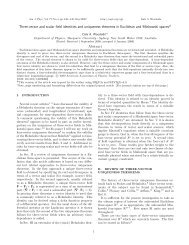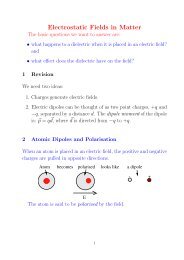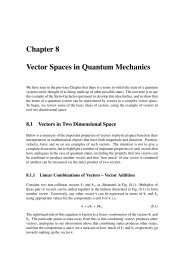AOS News - The Australian Optical Society - Macquarie University
AOS News - The Australian Optical Society - Macquarie University
AOS News - The Australian Optical Society - Macquarie University
- No tags were found...
Create successful ePaper yourself
Turn your PDF publications into a flip-book with our unique Google optimized e-Paper software.
<strong>AOS</strong> <strong>News</strong> Volume 25 Number 1 2011<strong>Australian</strong> expertise on spectroscopy andimporting techniques from the leadinglabs, at that stage almost excessively basedin the US, experiments about squeezingwere performed initially with Ba atomicbeams, then second harmonic generatorsand optical parametric oscillators, usingnon-linear crystals. By 1996 the work byPing Koy Lam, Tim Ralph, Andrew White,Charles Harb and Eleanor Huntington,Matt Sellars and others had reached theworld standard and we gained internationalrecognition. In parallel the ANU work onusing squeezed light evolved, in particularfor gravitational wave detection with manycontributions by David McClelland,Ben Buchler, Malcolm Gray and DanielShaddock and others. Fig 2 shows a scenefrom these days (1994) at ANU – withone of the table top experiments thatdemonstrated optical sensing below thequantum noise limit.Building the technology in photonand atom optics<strong>The</strong> quest of breaking the quantumnoise limit in any form made opticalsensing, the design of better lasers and betterinstruments the major driver. We helpedin perfecting the techniques and to makethem reliable. <strong>The</strong> theory teams were partof the emerging ideas of quantum controland quantum information processing.This <strong>Australian</strong> know how has now beenexported to several leading internationalgroups in Europe, US and Asia. Twotextbooks were written in Australia, oneon the practical aspects of quantum optics[5] and one on the theoretical foundationsof quantum optics [6] and both are widelyused around the world.In parallel, the ANU team generatedthe first ultra cold atoms in a magneticoptical trap , Ian Littler and investigatedthe diffraction of matter waves, KenFigure 3. Rb Atom laser team at ANU 2010, who are developing the technology for practicalatom interferometer with enhanced sensitivity. <strong>The</strong> machines get more reliable and moreprecise with each generation. Left John Debs, Mattias Johnsson, John Close, Paul Altin,Gordon McDonald, Rachel Poldy, Daniel Döring, NickRobins.Baldwin. <strong>The</strong> Otago team of AndrewWilson, Robert Ballagh and Wes Sandlewas the first to create a Bose EinsteinCondensate in the Southern Hemisphere,as it was then the catchphrase, soonfollowed by the ANU team led by JohnClose and followed by SUT with AndreiSidorov, and UQ with Halina RubinszteinDunlop.We now had in atomic physics a sourceof coherence and a starting point for morecomplex systems base on coherent matterwaves (see Fig 3). <strong>The</strong> way was open tobuild devices that are in close analogyto optics, we can propagate and focusmatter waves, build beam splitters andinterferometers, build atom lasers and havefull control of the coherent beam of atoms.<strong>The</strong> ANU team, with Andrew Truscott,uses single He* atom detection to showthe coherence properties. Refined theories,for from Matt Davis and Joe Hope andtheir teams, had to be developed to takethe complex nonlinear properties of thesequantum systems into account, to includeand exploit the wealth of properties BECexhibit at the condensation point andmore recently to include the propertiesof samples of Fermions at ultracoldtemperatures, Chris Vale and Hui Hu atSUT.In optics the emphasis shifted toexperiments using single photons, whichhad significant technical advantages andwere also encouraged by the developmentof the concepts and ideas of quantumentanglement. Around the world theimportance and capability of q-bits wereanalyzed, the mathematical link betweencomplex calculations and the evolutionof quantum systems were discovered andthis led to the predictions for quantumcomputing. In particular the interest infast factorisation, with all its implicationsfor cryptography, code breaking and othersecurity application, caught the attentionand created the new, rapidly expandingfield of quantum information theory.<strong>The</strong> big questions became quality of theentanglement, the ability to teleportinformation from one place to another,the quest for scalability to many q-bits andpractical error correction. This is exploitedin many experiments with pairs of photonscreated, for example in the teams ofAndrew White and Tim Ralph at UQ andother laboratories in Australia.Many suggestions were made howthis could be realized experimentally andFigure 2. Quantum optics teamat ANU 1994. From left: Ping KoyLam, Robert Batchko (Stanford),Ben Buchler, Hans Bachor, ElanorHuntington, Daniel Shaddock,Charles Harb and Tim Ralph. <strong>The</strong>foreground shows the componentsof an experiment demonstratingphase sensing below the quantumnoise limit.14
















